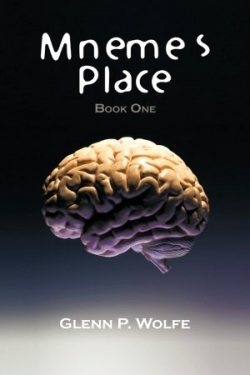Mneme's Place
Book One
To call Glenn P. Wolfe’s novel Mneme’s Place “Joycean” is an understatement. There is no doubt the author was inspired by James Joyce’s A Portrait of the Artist as a Young Man, Ulysses, and Finnegan’s Wake. Wolfe employs many of Joyce’s modernist techniques, including wordplay, rhyme, punning, and stream of consciousness. The results vary from poignant and clever to mass confusion.
Wolfe wrote detective and comedy teleplays for television series like Perry Mason, Surfside Six, and Bob Cummings. When he retired from television writing, Wolfe continued to compose books and plays. He is the author of two other novels, Do Not Go Gentle and Double Feature.
Published posthumously, Mneme’s Place is a unique, sometimes-brilliant-sometimes-chaotic, retelling and fabrication of the author’s bizarre family history and his experiences, all relayed through a protagonist named Ralph Jonas, an ex-television writer. The stream-of-consciousness writing Wolfe employs is also used by Jonas, blurring the line between author and protagonist. Where Wolfe is verbose and expounds on a multitude of subjects and disciplines through his characters, Jonas is overwhelmed by experience, to the point of almost having writer’s block. He feels he calls too much attention to himself as he jots down notes while he drinks in a crowded Dublin bar. These notes are supposed to contain ideas and inspirations for future writing projects, but they all tell him to “SHUT UP, JONAS.”
In full Joycean form and humor, Wolfe writes: “An incubator, he’d say, holding the notebook aloft. Here! The growth and development of wee bairns of comedy! Mewling, puling little curled darlings of japes and jocularity. Fries of satire, chits of bathos, slips of monkeyshine. Gaglets, waglets, quiplings and punkins. A housing for the succor and sustenance of custard pies in need of guidance, and legs of rubbering.” This type of wordplay goes on for pages, along with lists of people, places, and things.
The reader must understand that Wolfe did not make his novel easily accessible for a reason, and this is hinted at in the title. As a courtesy to the reader, Wolfe lists a few definitions of the word mneme. For example, in Greek mythology, Mneme is the muse of memory. In psychology, mneme is a term that describes “the persistent or recurrent effect of past experience of the individual or of the race.” It is also “the capacity for retaining after-effect of experience of stimulation.” If these definitions are considered, one cannot help but assume that Mneme’s Place, represented as a bar, is actually the knowledge, memory, and experiences of Jonas and possibly of Jonas’ ancestry—or, what Carl Jung called the collective unconscious. But, because Ralph Jonas is a fictional character, Mneme’s Place must actually be the collective unconscious of Wolfe.
Published posthumously, the text is loaded with experimental grammar, punctuation, language, jokes, puns, and rhymes. It is difficult to tell where blatant stylistic choices end and possible syntax errors and typos begin. Readers who like to digest their reading material slowly will enjoy Wolfe’s book. A tremendous effort, Mneme’s Place might be one final joke played by a man who helped write the comedy and drama that helped shape the American public’s collective unconscious.
Reviewed by
Lee Gooden
Disclosure: This article is not an endorsement, but a review. The publisher of this book provided free copies of the book and paid a small fee to have their book reviewed by a professional reviewer. Foreword Reviews and Clarion Reviews make no guarantee that the publisher will receive a positive review. Foreword Magazine, Inc. is disclosing this in accordance with the Federal Trade Commission’s 16 CFR, Part 255.

